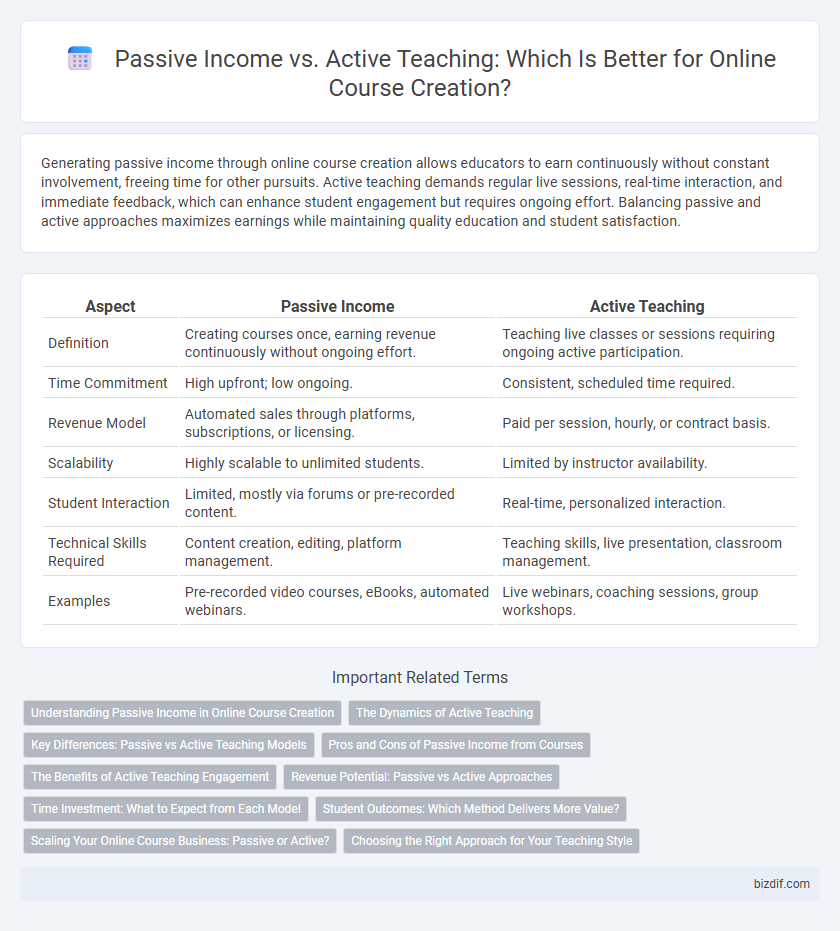Generating passive income through online course creation allows educators to earn continuously without constant involvement, freeing time for other pursuits. Active teaching demands regular live sessions, real-time interaction, and immediate feedback, which can enhance student engagement but requires ongoing effort. Balancing passive and active approaches maximizes earnings while maintaining quality education and student satisfaction.
Table of Comparison
| Aspect | Passive Income | Active Teaching |
|---|---|---|
| Definition | Creating courses once, earning revenue continuously without ongoing effort. | Teaching live classes or sessions requiring ongoing active participation. |
| Time Commitment | High upfront; low ongoing. | Consistent, scheduled time required. |
| Revenue Model | Automated sales through platforms, subscriptions, or licensing. | Paid per session, hourly, or contract basis. |
| Scalability | Highly scalable to unlimited students. | Limited by instructor availability. |
| Student Interaction | Limited, mostly via forums or pre-recorded content. | Real-time, personalized interaction. |
| Technical Skills Required | Content creation, editing, platform management. | Teaching skills, live presentation, classroom management. |
| Examples | Pre-recorded video courses, eBooks, automated webinars. | Live webinars, coaching sessions, group workshops. |
Understanding Passive Income in Online Course Creation
Passive income in online course creation arises from the ability to generate revenue continuously after the initial effort of course development and marketing. Unlike active teaching, which requires real-time interaction and ongoing time investment, passive income depends on automated sales funnels, evergreen content, and scalable distribution platforms such as Udemy or Teachable. Understanding this distinction enables creators to design courses that maximize long-term profitability with minimal direct engagement.
The Dynamics of Active Teaching
Active teaching in online course creation demands continuous engagement, regular content updates, and real-time interaction with students to enhance learning outcomes. Unlike passive income models that generate revenue with minimal ongoing effort, active teaching requires consistent time investment and adaptability to address learners' evolving needs. This dynamic approach fosters deeper student connections, improved course quality, and sustained educational impact.
Key Differences: Passive vs Active Teaching Models
Passive income in online course creation involves setting up content once and generating revenue continuously without ongoing interaction, leveraging pre-recorded videos, downloadable materials, and automated sales funnels. Active teaching requires real-time engagement with students through live sessions, personalized feedback, and interactive discussions, demanding consistent time and effort. The key difference lies in scalability and involvement: passive models enable broader reach with minimal maintenance, while active teaching fosters deeper learner connection but limits audience size due to time constraints.
Pros and Cons of Passive Income from Courses
Passive income from online courses offers scalability, allowing creators to earn revenue continuously without constant involvement, which makes it ideal for long-term financial freedom. However, initial course creation requires significant time and effort to produce high-quality content, and ongoing updates or marketing are necessary to maintain consistent sales. Unlike active teaching, passive income may lack immediate interaction and feedback, potentially affecting student engagement and course improvement.
The Benefits of Active Teaching Engagement
Active teaching engagement in online course creation fosters deeper connections with students, enhancing learning outcomes and increasing course completion rates. Instructors receive immediate feedback, enabling real-time content adjustments that improve course quality and student satisfaction. This hands-on involvement often leads to stronger personal branding and long-term student loyalty, driving sustained growth in educational offerings.
Revenue Potential: Passive vs Active Approaches
Passive income from online courses generates revenue continuously with minimal ongoing effort by leveraging pre-recorded content and automated sales funnels. Active teaching, such as live sessions and personalized coaching, demands constant time investment, potentially limiting scalability but allowing premium pricing and higher per-student revenue. Maximizing revenue potential often involves integrating both approaches to balance consistent passive earnings with high-value active engagement.
Time Investment: What to Expect from Each Model
Active teaching demands continuous time investment for live sessions, personalized feedback, and real-time interaction with students, often leading to unpredictable work hours. Passive income from online courses requires significant upfront effort to develop comprehensive content, but once established, it generates revenue with minimal ongoing time commitment. Understanding these differences helps educators balance immediate workload against long-term financial benefits when choosing their course delivery model.
Student Outcomes: Which Method Delivers More Value?
Passive income models in online course creation allow educators to earn revenue through pre-recorded content with minimal ongoing effort, yet may limit personalized feedback and tailored support. Active teaching involves real-time interaction, mentorship, and adaptive learning strategies, significantly enhancing student outcomes by addressing individual needs and encouraging engagement. Courses combining scalable passive content with periodic live sessions often maximize value by balancing flexibility with effectiveness in skill development and knowledge retention.
Scaling Your Online Course Business: Passive or Active?
Scaling your online course business hinges on balancing passive income generated through automated sales funnels and active teaching that fosters direct engagement and higher course completion rates. Passive income strategies, such as evergreen course offerings and subscription models, enable continuous revenue with minimal ongoing effort, while active teaching demands time-intensive live sessions or personalized mentoring that build strong student relationships and brand loyalty. Optimizing this balance leverages scalable automation alongside high-impact interactions, maximizing growth and profitability in the competitive e-learning market.
Choosing the Right Approach for Your Teaching Style
Passive income in online course creation allows educators to generate revenue through pre-recorded content, ideal for those who prefer a scalable, hands-off approach. Active teaching involves live interactions and real-time feedback, suiting instructors who value direct engagement and personalized support. Selecting the right approach depends on your teaching style, availability, and desired level of student interaction to optimize both income and educational impact.
Passive income vs Active teaching Infographic

 bizdif.com
bizdif.com